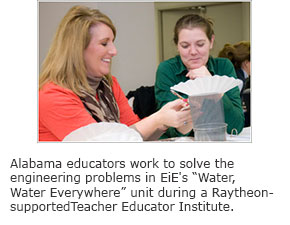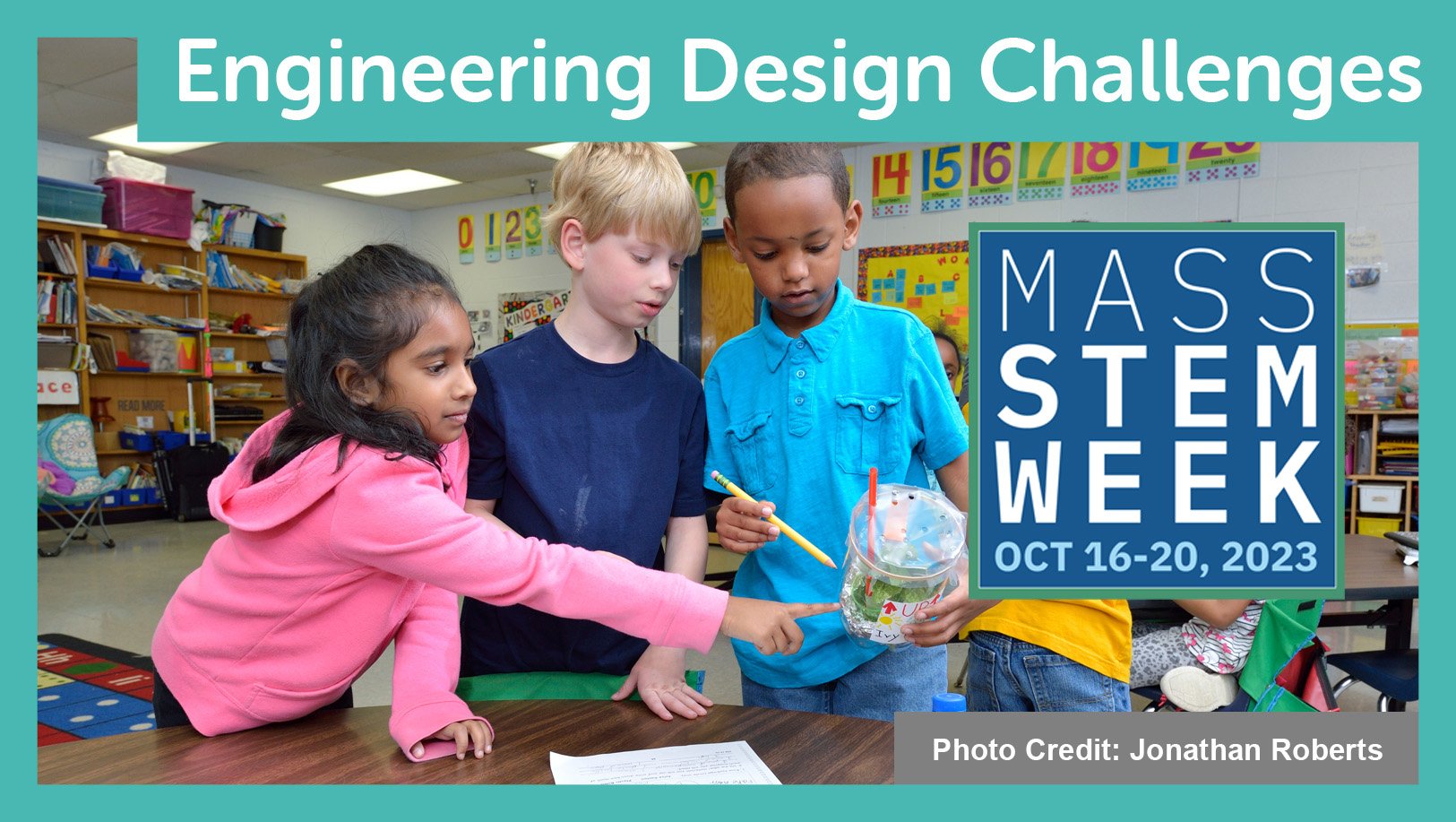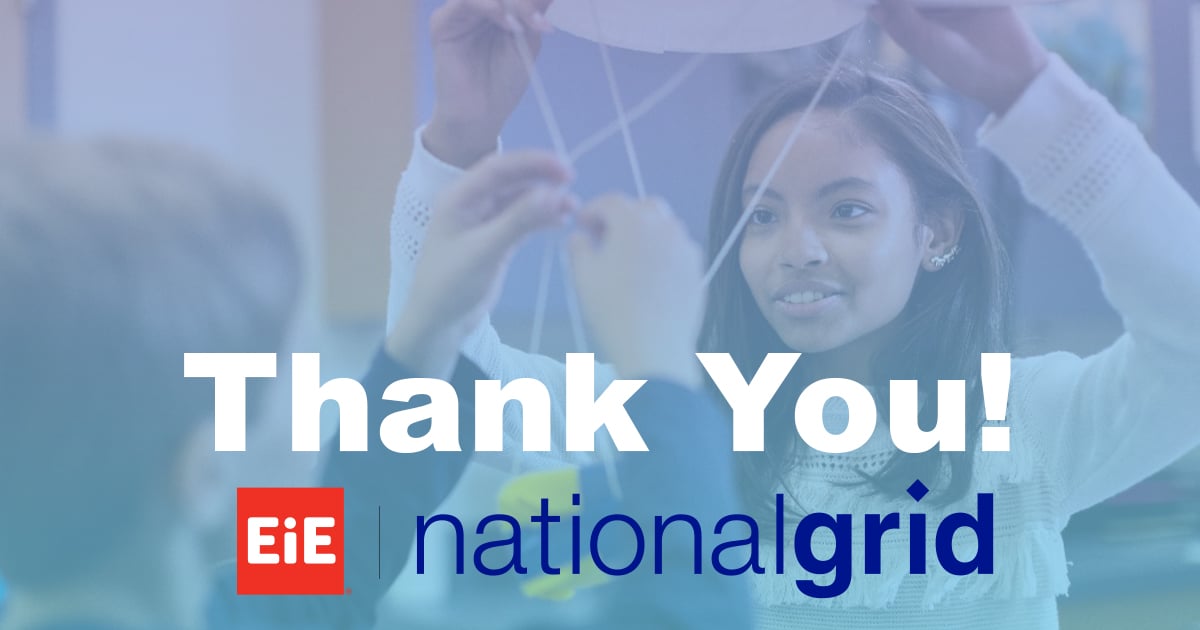
You’ve heard of the multiplier effect, where an initial investment has a bigger-than-expected result. It works for our national economy, where every dollar spent in the manufacturing sector generates $1.35 in economic activity. It can also work in our schools.
Insufficient professional development (PD) for STEM teachers is one of the most important challenges that schools currently face, according to the 2010 National Survey on STEM Education. Meanwhile, according to a report from the government’s Institute of Education Sciences, high-quality PD for teachers can have a positive impact on students.
An EiE initiative supported by the technology company Raytheon is using the multiplier effect to make sure an initial investment in PD has the widest reach possible. In 2011 Raytheon made a significant award to the Museum of Science, Boston, with the goal of jumpstarting engineering education for young children by making EiE’s hands-on, learner-driven PD more widely available to elementary teachers in three regions. Today, three organizations—the Arizona Science Center (ASC), the Alabama Mathematics, Science, Technology, and Engineering Coalition (AMSTEC) for Education at the University of Alabama – Huntsville, and the Office of Curriculum and Instruction at the District of Columbia Public Schools (DCPS)—have become EiE collaborators thanks to Raytheon support and are using a “train the trainer” model to achieve the multiplier effect.
We’re just starting to process the data from the initiative, but some exciting stories are coming to light. In Arizona, the teacher educators who completed the Raytheon-supported PD workshop at ASC are already making an impact in schools; for example Joelle Clark and Lori Rubino-Hare, who are PD providers for Northern Arizona University’s Center for Science Teaching and Learning, have offered EiE workshops attended by dozens of Arizona teachers. They’ve also introduced EiE to students at the university who are preparing to become elementary teachers.
That’s just one example. We’re excited to be working with Raytheon to address the need for exemplary STEM PD—and to see more examples of the multiplier effect in action.
Engineering is Elementary is a project of the National Center for Technological Literacy at the http://www.mos.org/.
You’ve heard of the multiplier effect, where an initial investment has a bigger-than-expected result. It works for our national economy, where every dollar spent in the manufacturing sector generates $1.35 in economic activity. It can also work in our schools.
Insufficient professional development (PD) for STEM teachers is one of the most important challenges that schools currently face, according to the 2010 National Survey on STEM Education. Meanwhile, according to a report from the government’s Institute of Education Sciences, high-quality PD for teachers can have a positive impact on students.
An EiE initiative supported by the technology company Raytheon is using the multiplier effect to make sure an initial investment in PD has the widest reach possible. In 2011 Raytheon made a significant award to the Museum of Science, Boston, with the goal of jumpstarting engineering education for young children by making EiE’s hands-on, learner-driven PD more widely available to elementary teachers in three regions. Today, three organizations—the Arizona Science Center (ASC), the Alabama Mathematics, Science, Technology, and Engineering Coalition (AMSTEC) for Education at the University of Alabama – Huntsville, and the Office of Curriculum and Instruction at the District of Columbia Public Schools (DCPS)—have become EiE collaborators thanks to Raytheon support and are using a “train the trainer” model to achieve the multiplier effect.
We’re just starting to process the data from the initiative, but some exciting stories are coming to light. In Arizona, the teacher educators who completed the Raytheon-supported PD workshop at ASC are already making an impact in schools; for example Joelle Clark and Lori Rubino-Hare, who are PD providers for Northern Arizona University’s Center for Science Teaching and Learning, have offered EiE workshops attended by dozens of Arizona teachers. They’ve also introduced EiE to students at the university who are preparing to become elementary teachers.
That’s just one example. We’re excited to be working with Raytheon to address the need for exemplary STEM PD—and to see more examples of the multiplier effect in action.
EiE is a project of the Museum of Science’s National Center for Technological Literacy©
You’ve heard of the multiplier effect, where an initial investment has a bigger-than-expected result. It works for our national economy, where every dollar spent in the manufacturing sector generates $1.35 in economic activity. It can also work in our schools.
Insufficient professional development (PD) for STEM teachers is one of the most important challenges that schools currently face, according to the 2010 National Survey on STEM Education. Meanwhile, according to a report from the government’s Institute of Education Sciences, high-quality PD for teachers can have a positive impact on students.
An EiE initiative supported by the technology company Raytheon is using the multiplier effect to make sure an initial investment in PD has the widest reach possible. In 2011 Raytheon made a significant award to the Museum of Science, Boston, with the goal of jumpstarting engineering education for young children by making EiE’s hands-on, learner-driven PD more widely available to elementary teachers in three regions. Today, three organizations—the Arizona Science Center (ASC), the Alabama Mathematics, Science, Technology, and Engineering Coalition (AMSTEC) for Education at the University of Alabama – Huntsville, and the Office of Curriculum and Instruction at the District of Columbia Public Schools (DCPS)—have become EiE collaborators thanks to Raytheon support and are using a “train the trainer” model to achieve the multiplier effect.
We’re just starting to process the data from the initiative, but some exciting stories are coming to light. In Arizona, the teacher educators who completed the Raytheon-supported PD workshop at ASC are already making an impact in schools; for example Joelle Clark and Lori Rubino-Hare, who are PD providers for Northern Arizona University’s Center for Science Teaching and Learning, have offered EiE workshops attended by dozens of Arizona teachers. They’ve also introduced EiE to students at the university who are preparing to become elementary teachers.
That’s just one example. We’re excited to be working with Raytheon to address the need for exemplary STEM PD—and to see more examples of the multiplier effect in action.
EiE is a project of the Museum of Science’s National Center for Technological Literacy©








